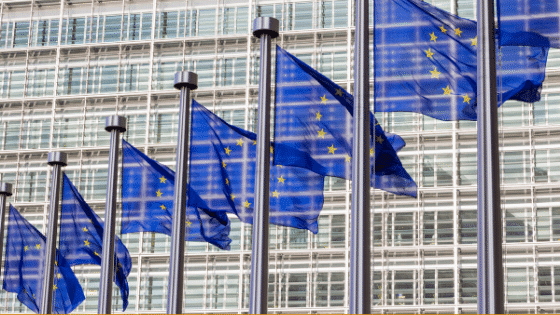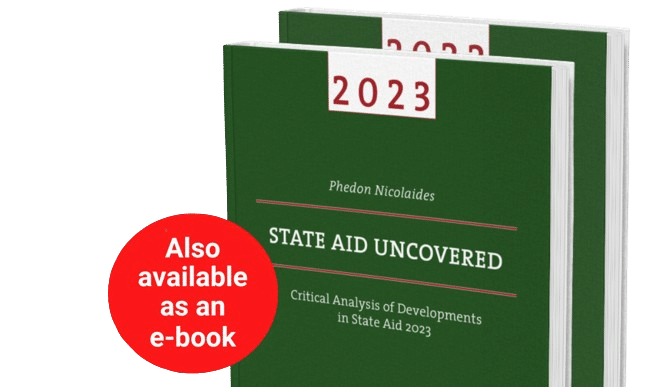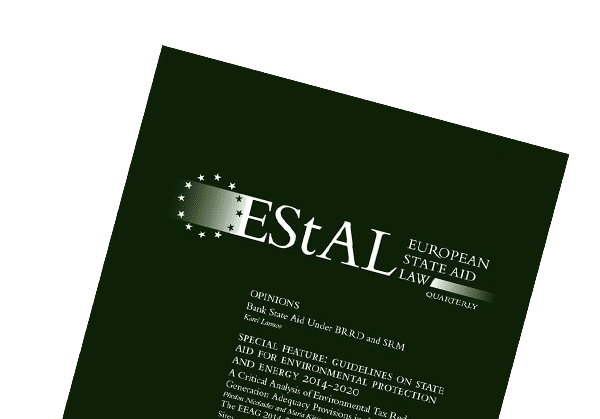
Introduction
Despite the apprehension and even remonstrations of Member States, more transparency should be welcomed. It should improve our and their knowledge of the impact of State aid on actual and potential competition. But if the ultimate objective is to incentivise Member States not to grant illegal [non-notified] or incompatible State aid, they should also be helped understand better under which conditions a public measure may constitute State aid and how such aid may be made compatible with the internal market. Here the Commission has a huge task and bears significant responsibility.
Ultimately, this is the main reason why the Commission is about to adopt the definitive version of its communication on the notion of State aid. But it is not just this communication that will help Member States to comprehend the meaning of State aid. In fact, the educational value of the communication is unlikely to be substantial. This is because it largely summarises principles in established case law. The summary is well done, but pretty much of what is written in the communication is already well known.
Member States benefit more where the Commission clarifies its views on issues not covered by case law, especially when these issues concern the design of State aid measures. Aid granting authorities are naturally more involved and interested in how to design measures that do not include State aid or, if aid is unavoidable, they need to know how to ensure the compatibility of the aid. It follows that more transparency is also useful on the compatibility side of State aid.
In the Staff Working Paper on Ex Post Evaluation of 28 May 2014, the Commission correctly states: “It is essential for decision makers both at the Member State and EU level to consider the measurable results of State aid granted in the past, and the lessons learnt. This will help to ensure that schemes financed by State aid are more effective and create less distortion in markets, and will also improve the efficiency of future schemes and, possibly, of future rules for granting State aid.”[2] In the future, the Commission will not authorise State aid that proves to be ineffective in achieving its objective.
So far, the public discussion on transparency has focused on what Member States do. If transparency is intended as a tool for making State aid less distortionary and more effective, I would argue that we need to have more transparency at the Commission level too. The Commission should explain better and in more detail its decisions which either find that there is State aid, or else declare it to be compatible with the internal market.
As Member State use the GBER more extensively, the number of Commission decisions will decline. This is the intended objective of SAM. But as the number of decisions declines, their educational value will increase. Perhaps because there will be fewer of them and because they will mostly concern measures subject to detailed assessment, they will be more carefully argued. But at present, many of them are sloppily drafted.
In a number of articles in the blog I have highlighted decisions which appear to be incompletely reasoned or to make assertions which are not founded on the underlying facts. In this article I review two recent decisions of the Commission, both of which conclude with a finding of compatibility. However, as I explain below, they contain many puzzling and insufficiently motivated statements.
In the first case, the Commission fails to give a clear explanation why it believes the measure in question may contain State aid. In the second case, the Commission approves of tate aid to a project of questionable viability.
Existence of State Aid: Multiarena in Copenhagen [Commission Decision 2014/297][3]
During the past couple of years, the Commission has examined quite a number of infrastructural projects such as ports, airports, arenas and stadiums. Apart from the financing of airlines operating out of regional airports – which are not really infrastructural projects – the Commission in most cases has found public funding to constitute aid that is compatible with the internal market without first opening the formal investigation procedure. In other words it did not entertain serious doubts on the compatibility of the aid. Unusually, however, in the case of the Copenhagen arena, it did have serious doubts. The Decision which is reviewed here was adopted after such a procedure.
Do you know we also publish a journal on State aid?

The European State Aid Law Quarterly is available online and in print, and our subscribers benefit from a reduced price for our events.
Background
The measure was notified to the Commission in December 2011. At the same time the Commission received two complaints. What is of interest in this case is not the possible impact of the new arena on other existing facilities but the way the Commission established the existence of State aid.
The arena project was established and owned by the city of Copenhagen and Realdania, a private foundation. The city of Copenhagen and the Danish state also contributed land for free.
The construction was to be awarded through an open tender. The operation of the arena had already been awarded to a separate entity also through an open tender.
Existence of State aid
There was no doubt that payments and contributions in kind [land] by the state and the city were state resources. There was also no doubt that the arena would be used primarily for economic activities and that it would have an impact on cross-border trade.
However, there were doubts concerning payments by “DIF” which was an umbrella organisation for 61 sports federations partly funded by the state and proceeds from the state lottery and other gambling operations. The Commission accepted the position of the Danish authorities that DIF’s decisions could not be imputed to the state. DIF’s governing bodies were elected without any influence from public authorities. Moreover, public authorities did not influence the individual decisions adopted by DIF’s governing bodies. Therefore, payments by DIF were found by the Commission not to constitute State aid [paragraph 39].
With respect to the operator of the arena, the Commission acknowledged that the management of the arena was tendered out in accordance with EU public procurement rules. The operator was selected through an open, transparent and non-discriminatory procedure in which the price (financial and commercial terms) was given a relative weight of approximately 75%. All interested parties had an equal opportunity to bid for the operator contract and the contract was awarded to the bidder with the best offer. The tender was launched in April 2011 and was widely advertised. All parties submitting responses to a pre-qualification questionnaire satisfied the project’s requirements and were invited to advance to Stage 1 of the procurement competition in June 2011. Three Stage 1 tenders were submitted and two bidders were short-listed for Stage 2 and later submitted bids.
The evaluation included the strength of the financial offer, legal terms, facilities requirements, services and deliverability and risk. Both bids were strong, but the selected operator scored higher in most of the categories, and in particular, it offered a fixed lease that was significantly higher than the other bidder’s.
The selected operator accepted to pay rent consisting of an annual fixed component and a variable component [whose amounts were deleted as business secrets from the Decision]. The lease would be for a term of at least 25 years [the Danish authorities explained that long term contracts from 20-30 years were not unusual].
Having presented all these features of the selection procedure and the contractual clauses, the Commission went on to make this puzzling statement:
“(44) While these arrangements minimise the advantage to the selected operator to the minimum necessary to ensure operation of the infrastructure, an advantage to the operator of this new arena cannot be excluded. However, given that such aid would be compatible with the internal market, as demonstrated below, it is not necessary to make a definitive finding about the existence of aid.”
For public officials and professionals who deal with State aid and for the complainants too this is a very frustrating statement. Why is it that an advantage cannot be excluded? On which grounds? This finding of advantage and, of course, State aid may make no practical difference to the Commission or to Denmark, because the project is approved, but to those who need to know how to design measures to exclude the granting of State aid, the statement in paragraph 44 of the Decision confuses rather than illuminates. How can an operator, who is selected on the basis of a competitive process, derive an advantage? And why is it that, in many other cases, the Commission routinely finds that competitive selection eliminates advantage? We are simply left in the dark as to what caused the Commission to be unable to exclude the possibility of State aid.
The ambiguity is extended to the users of the arena. According to the lease agreement, the operator has to make the arena available to a variety of users and for a variety of activities and cannot award preferential treatment to any specific type of activities. This is to ensure the multifunctional use of the arena. All users must be charged on market terms. In this respect, the lease agreement states that “the rates charged for use shall always be at the market rates reasonably obtainable in the open market for that particular use” [paragraph 45]. The operator is also free to set prices on a commercial basis and cannot discriminate between users. Thus, according to the Commission’s own admission, “the arena is multifunctional and open to all with no captive user” [paragraph 45].
But again, in the next paragraph the Commission concludes that it cannot exclude the presence of advantage “(47). The renting of the arena may constitute aid for the users, if the users can be considered undertakings within the meaning of Article 107 of the Treaty and if the rent they pay is below the rent for the use of comparable infrastructure under normal market conditions. Non-professional users do not qualify as undertakings within the meaning of Article 107 of the Treaty. In this case though, given that such aid would be compatible with the internal market, as demonstrated below, it is not necessary to make a definitive finding about the existence of aid”.
Once more, we see the Commission reaching a surprising conclusion. First, it explains at length that the operator of the arena will charge market prices and that, given its need to make profit, it has no incentive to charge a sub-market price. Then, it declares that if the rent is below market level, users which are undertakings will receive State aid. But it does not explain why the rent could be below market level. In fact, it remains completely unclear on which grounds the Commission considers that the rent could be at sub-market level.
Compatibility of State aid: Polish LNG terminal [SA.31953][4]
The Danish measure above concerned the possible existence of State aid. This section examines a Polish measure where the issue at hand was the compatibility of aid. It is often presumed that aid to loss-making projects or companies will not distort competition too much, because the loss-making project will eventually have to be terminated and the loss-making company will eventually go bankrupt. But this presumption is wrong. Competition is distorted without society reaping the compensatory benefits of investments that can make long-term contributions to the economy.
In the case at hand, Poland notified aid of PLN 926 million for the construction and operation of a liquefied natural gas [LNG] terminal owned by Polskie LNG [PLNG], a 100% subsidiary of the Polish Gas Transmission Operator [PGTO]. The aid would come from EU structural funds and corresponded to intensity of 57% of eligible costs of PLN 1624 million. The total investment costs were PLN 2772 million.
Without aid, the financial rate of return [FRR] [which is also called internal rate of return (IRR)] was 3.37% and the net present value [NPV] was – PLN 904 million. With the aid, the FRR rose to 7.37% and the NPV dropped to – PLN 90 million. The NPV was calculated using a nominal discount rate of 8%. Yet, for 2011, the Polish energy regulator [ERO] set gas tariffs at a high enough level so that they would render a rate of return on capital of 9.6%.
The period of the calculations was 28 years, but the terminal was assumed to have a life of 40 years.
The Commission approved the aid because the FRR and NPV showed that it was necessary and proportional.
However, the case is puzzling for the following reasons:
First, why would PLNG and PGTO finance a project whose return would be lower than their cost of capital [assuming that the regulated return on capital of 9.6% was equal to the real cost of capital]? Since it is unlikely that PLNG and PGTO were economically irrational, there must have been benefits in the investment that the cost-benefit analysis had ignored.
Second, even after the aid was factored in the calculations, the NPV [at the nominal 8%] was still negative and the FRR was lower than the used discount rate. Why would even a relatively small loss be acceptable? Again, could it be that PLNG and PGTO obtained benefits other than the financial return from the operation of the terminal?
Third, why use a nominal rate of 8% when the return on capital was 9.6%?
The Commission decision indicates that the terminal is the first one in the Baltic Sea shore. It also indicates that two similar investments were being undertaken in Finland and Lithuania. Yet, without further explanation, it merely states that the Polish terminal is “unlikely to endanger” them [paragraph 70]. Could PGTO possibly obtain a first mover advantage?
The decision also envisages that downstream competitors of PGTO will import gas through the terminal. Increased importation of LNG will indeed intensify downstream competition, provided that the access to the terminal will be non-discriminatory and that PLNG will not attempt to implement margin squeeze.
The question, however, remains why PLNG would go ahead with a loss-making project, and why the prospect of losses and their impact on competitors were not taken into account in the State aid assessment?
[1] The Communication can be accessed at
http://ec.europa.eu/competition/state_aid/modernisation/state_aid_transparency_en.pdf
[2] The text of the Working Paper can be accessed at:
http://ec.europa.eu/competition/state_aid/modernisation/state_aid_evaluation_methodology_en.pdf
[3] The text of the Commission Decision, as published in OJ L152, 22/5/2014, can be accessed at
http://eur-lex.europa.eu/legal-content/EN/TXT/PDF/?uri=CELEX:32014D0297&from=EN
[4] The text of the Commission Decision can be accessed at
http://ec.europa.eu/competition/state_aid/cases/241631/241631_1267250_72_3.pdf


